
Für eine deutsche Übersetzung dieser Seite einfach die Brandenburger Flagge anklicken
 |
Click the Brandenburg Flag for a German translation Für eine deutsche Übersetzung dieser Seite einfach die Brandenburger Flagge anklicken |


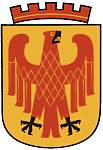 |
Home Towns - Potsdam, Germany
Unity Square |
 |



 |
This site is part of our Potsdam, Germany site. Click the left turn sign to get back to the Potsdam Start Site. |


 |
| Between the Old Market Square and Basin Square lies Unity Square, the oldest of Potsdam's downtown squares. Like many places in modern day Potsdam, this is reclaimed land. Up until the 1600s, there was a lake, called Niklas Lake covering this area. It was filled up in the 1600s to make room for new developments, leaving only a small pond, called the Foul Lake. |

 |
During the first Baroque City Extension, in 1724, King Frederick William I
had the Foul Lake filled up too, but it soon turned out that the reclaimed ground was not stable enough to build houses on it. Instead,
it was turned into an orchard, surrounded by baroque houses built along the former shoreline of Niklas Lake. Since 1765, two trails crossed the area. Amidst all the changes in the following centuries, the trail cross remained a permanent feature up to
the present day.
Since 1765, two trails crossed the area. Amidst all the changes in the following centuries, the trail cross remained a permanent feature up to
the present day. Around 1790, the square was named William's Square in honor of Soldier King Frederick William I.
Around 1790, the square was named William's Square in honor of Soldier King Frederick William I.Foul Lake Orchard in 1776 |

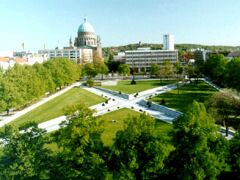 |
In 1731, the ground started to sink again and the whole square had to be filled up again. Royal gardener Peter Joseph
Lenné gave the square a new design. He again
re-designed the place in 1862. After World War II, the square was first simply used to grow food. Renamed Unity Square, it became part of the socialist overhauling of town. In 1979, depressions forming in the former lake area were filled up, yet again.  In 1999, after Potsdam was elected to host the 2001 Federal Horticulture Exhibition, the square was given its current attire by landscape firm Wes & Partner. Unity Square today |

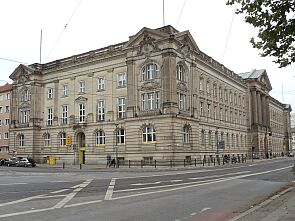 |
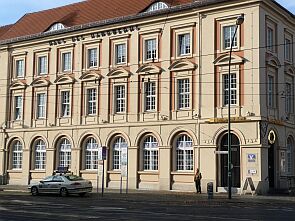 |
 |
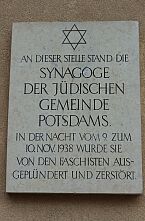
|
Of all the buildings surrounding the square, only the Post Office building (above left), built in 1900 and two smaller buildings survived the
1945 air raid. Some of them, like the House of Trade Guilds (above center) were rebuilt in their original style; some were replaced by simple
concrete slab houses. The house next to the post office (above right) is particularly interesting, since it marks the former location of Potsdam's Synagogue which had been at this place since 1767. The Synagogue was ransacked and plundered in 1938 during the Novemberpogrome. A granite plaque is the only reminder of this sad part of the town's history. |

 Of all the concrete slab building erected here in the 1960s, 70s and 80s, one stands out particularly - the State Library. Originally, there was an ensemble of baroque houses between Old Market Square and Unity Square. It was damaged in World War II and demolished in the 1960s, together with the City Castle.  In the 1970s a modern looking ensemble, consisting of the library and a teacher's seminar, complete with auditorium, refectory, gym and three inner courtyards was put in place. The library was designed by architects S. Weber, H. Ebert, P. Mylo, and F. Neuendorf, the seminar building by S. Weber, W. Merz, D. Lietz and H. Gödicke. We have more about the building at our Old Market Sqare site.  The library is going to get a new facade by 2011, the rest of the building is going to be demolished as part of inner city reconstruction efforts. |
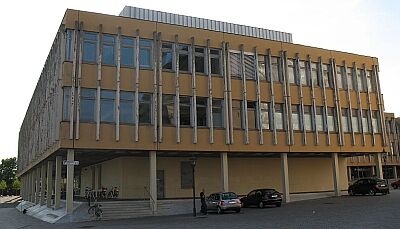
|

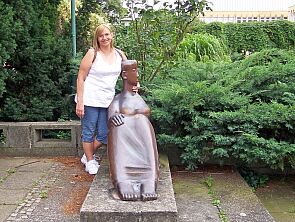 |
To keep the record straight, it wasn't the communist government that destroyed the original buildings, but a war started by Nazi-Germany.
However, we are looking forward to getting this one replaced by something more appealing. In front of the building is one of the last communist era monuments in town: It shows the 11th of Karl Marx' famous Theses on Feuerbach, circling the globe. |
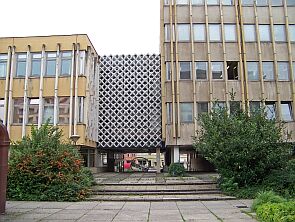
|
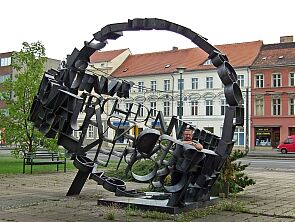 |
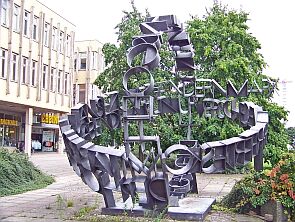 |
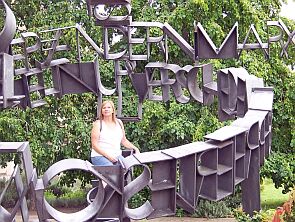
|
 |
THE PHILOSOPHERS HAVE ONLY INTERPRETED THE WORLD IN VARIOUS WAYS. THE POINT, HOWEVER, IS TO CHANGE IT. Marx' original handwriting |


 |
At the end of our tour, we'd like to show two monuments located at the square. One is a typical communist era
monument, honoring the victims of Nazi tyranny (above). The inscription at the wall reads: Our Sacrifice, Our Struggle against fascism and war - a reminder and an obligation to those who survived. 

|